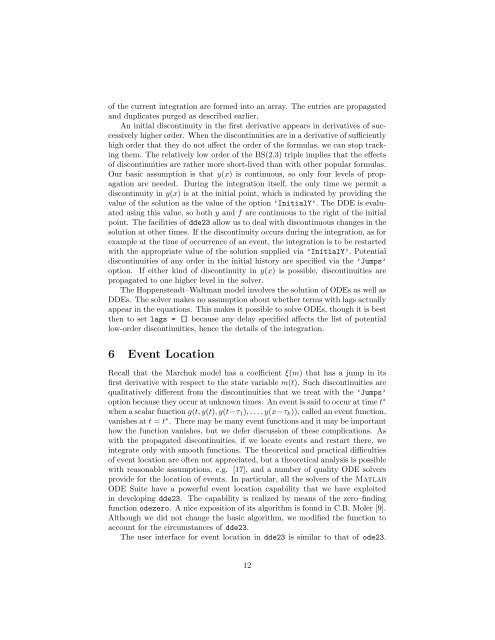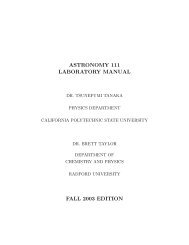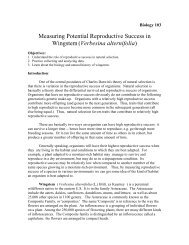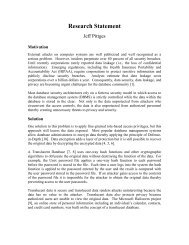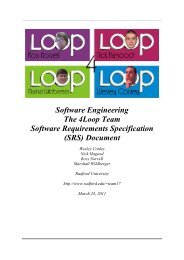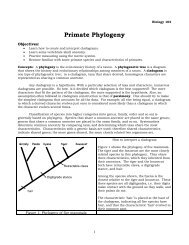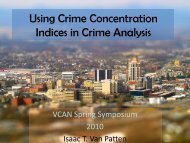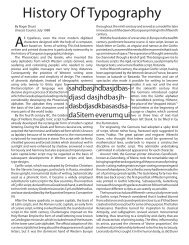Solving DDEs in Matlab - Radford University
Solving DDEs in Matlab - Radford University
Solving DDEs in Matlab - Radford University
You also want an ePaper? Increase the reach of your titles
YUMPU automatically turns print PDFs into web optimized ePapers that Google loves.
of the current <strong>in</strong>tegration are formed <strong>in</strong>to an array. The entries are propagated<br />
and duplicates purged as described earlier.<br />
An <strong>in</strong>itial discont<strong>in</strong>uity <strong>in</strong> the first derivative appears <strong>in</strong> derivatives of successively<br />
higher order. When the discont<strong>in</strong>uities are <strong>in</strong> a derivative of sufficiently<br />
high order that they do not affect the order of the formulas, we can stop track<strong>in</strong>g<br />
them. The relatively low order of the BS(2,3) triple implies that the effects<br />
of discont<strong>in</strong>uities are rather more short-lived than with other popular formulas.<br />
Our basic assumption is that y(x) is cont<strong>in</strong>uous, so only four levels of propagation<br />
are needed. Dur<strong>in</strong>g the <strong>in</strong>tegration itself, the only time we permit a<br />
discont<strong>in</strong>uity <strong>in</strong> y(x) is at the <strong>in</strong>itial po<strong>in</strong>t, which is <strong>in</strong>dicated by provid<strong>in</strong>g the<br />
value of the solution as the value of the option ’InitialY’. The DDE is evaluated<br />
us<strong>in</strong>g this value, so both y and f are cont<strong>in</strong>uous to the right of the <strong>in</strong>itial<br />
po<strong>in</strong>t. The facilities of dde23 allow us to deal with discont<strong>in</strong>uous changes <strong>in</strong> the<br />
solution at other times. If the discont<strong>in</strong>uity occurs dur<strong>in</strong>g the <strong>in</strong>tegration, as for<br />
example at the time of occurrence of an event, the <strong>in</strong>tegration is to be restarted<br />
with the appropriate value of the solution supplied via ’InitialY’. Potential<br />
discont<strong>in</strong>uities of any order <strong>in</strong> the <strong>in</strong>itial history are specified via the ’Jumps’<br />
option. If either k<strong>in</strong>d of discont<strong>in</strong>uity <strong>in</strong> y(x) is possible, discont<strong>in</strong>uities are<br />
propagated to one higher level <strong>in</strong> the solver.<br />
The Hoppensteadt–Waltman model <strong>in</strong>volves the solution of ODEs as well as<br />
<strong>DDEs</strong>. The solver makes no assumption about whether terms with lags actually<br />
appear <strong>in</strong> the equations. This makes it possible to solve ODEs, though it is best<br />
then to set lags = [] because any delay specified affects the list of potential<br />
low-order discont<strong>in</strong>uities, hence the details of the <strong>in</strong>tegration.<br />
6 Event Location<br />
Recall that the Marchuk model has a coefficient ξ(m) that has a jump <strong>in</strong> its<br />
first derivative with respect to the state variable m(t). Such discont<strong>in</strong>uities are<br />
qualitatively different from the discont<strong>in</strong>uities that we treat with the ’Jumps’<br />
option because they occur at unknown times. An event is said to occur at time t ∗<br />
when a scalar function g(t, y(t), y(t−τ1), . . . , y(x−τk)), called an event function,<br />
vanishes at t = t ∗ . There may be many event functions and it may be important<br />
how the function vanishes, but we defer discussion of these complications. As<br />
with the propagated discont<strong>in</strong>uities, if we locate events and restart there, we<br />
<strong>in</strong>tegrate only with smooth functions. The theoretical and practical difficulties<br />
of event location are often not appreciated, but a theoretical analysis is possible<br />
with reasonable assumptions, e.g. [17], and a number of quality ODE solvers<br />
provide for the location of events. In particular, all the solvers of the <strong>Matlab</strong><br />
ODE Suite have a powerful event location capability that we have exploited<br />
<strong>in</strong> develop<strong>in</strong>g dde23. The capability is realized by means of the zero–f<strong>in</strong>d<strong>in</strong>g<br />
function odezero. A nice exposition of its algorithm is found <strong>in</strong> C.B. Moler [9].<br />
Although we did not change the basic algorithm, we modified the function to<br />
account for the circumstances of dde23.<br />
The user <strong>in</strong>terface for event location <strong>in</strong> dde23 is similar to that of ode23.<br />
12


